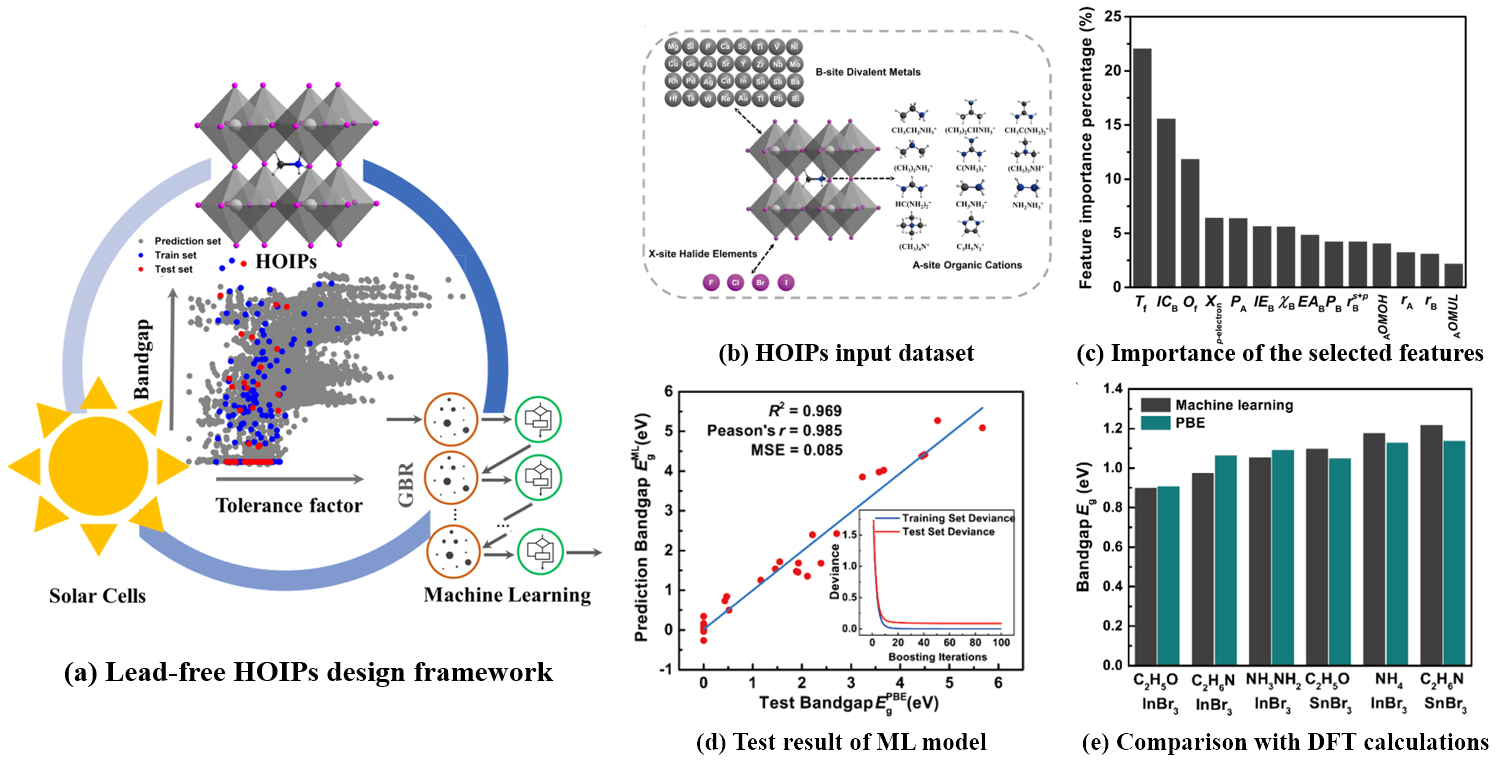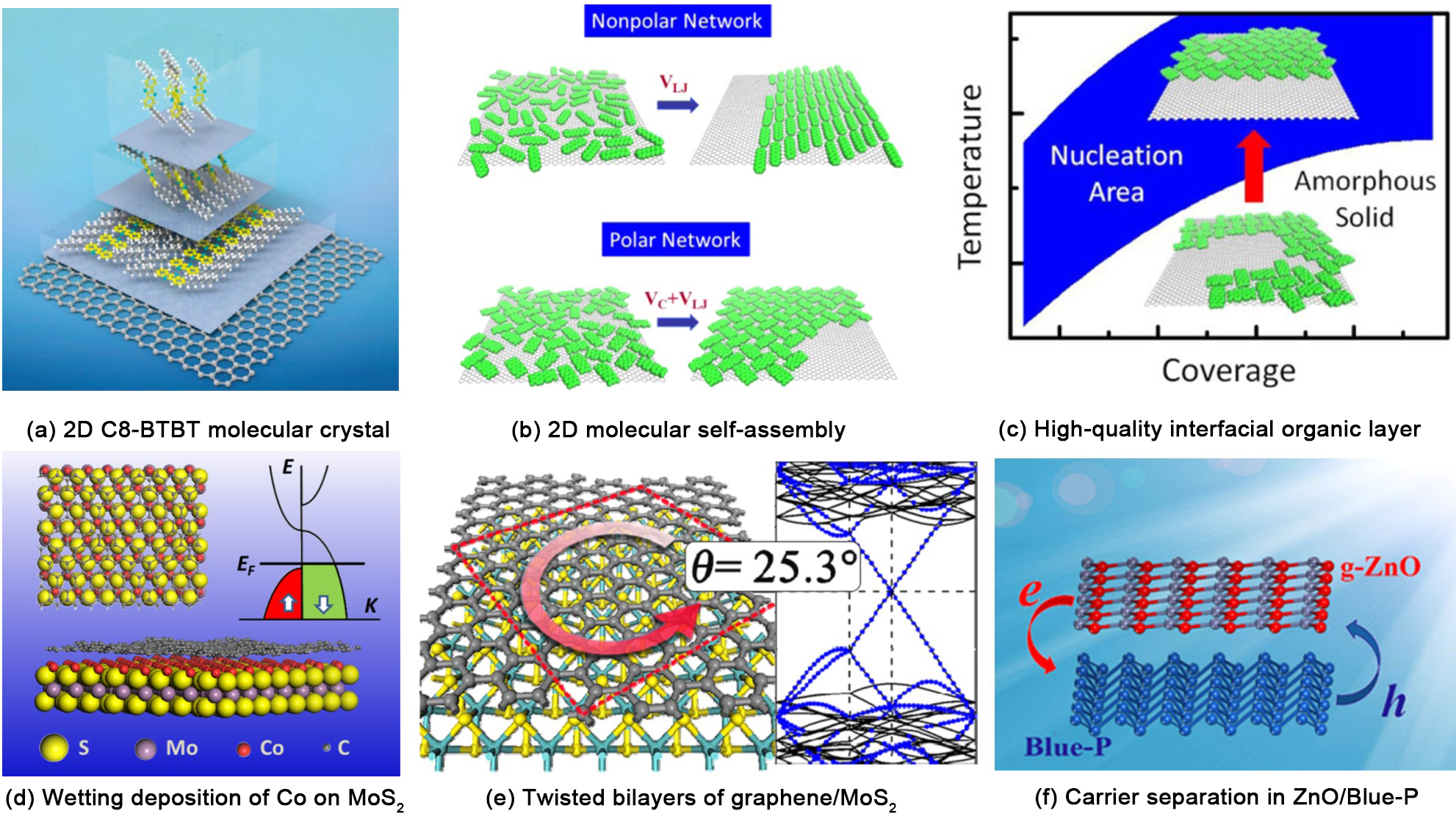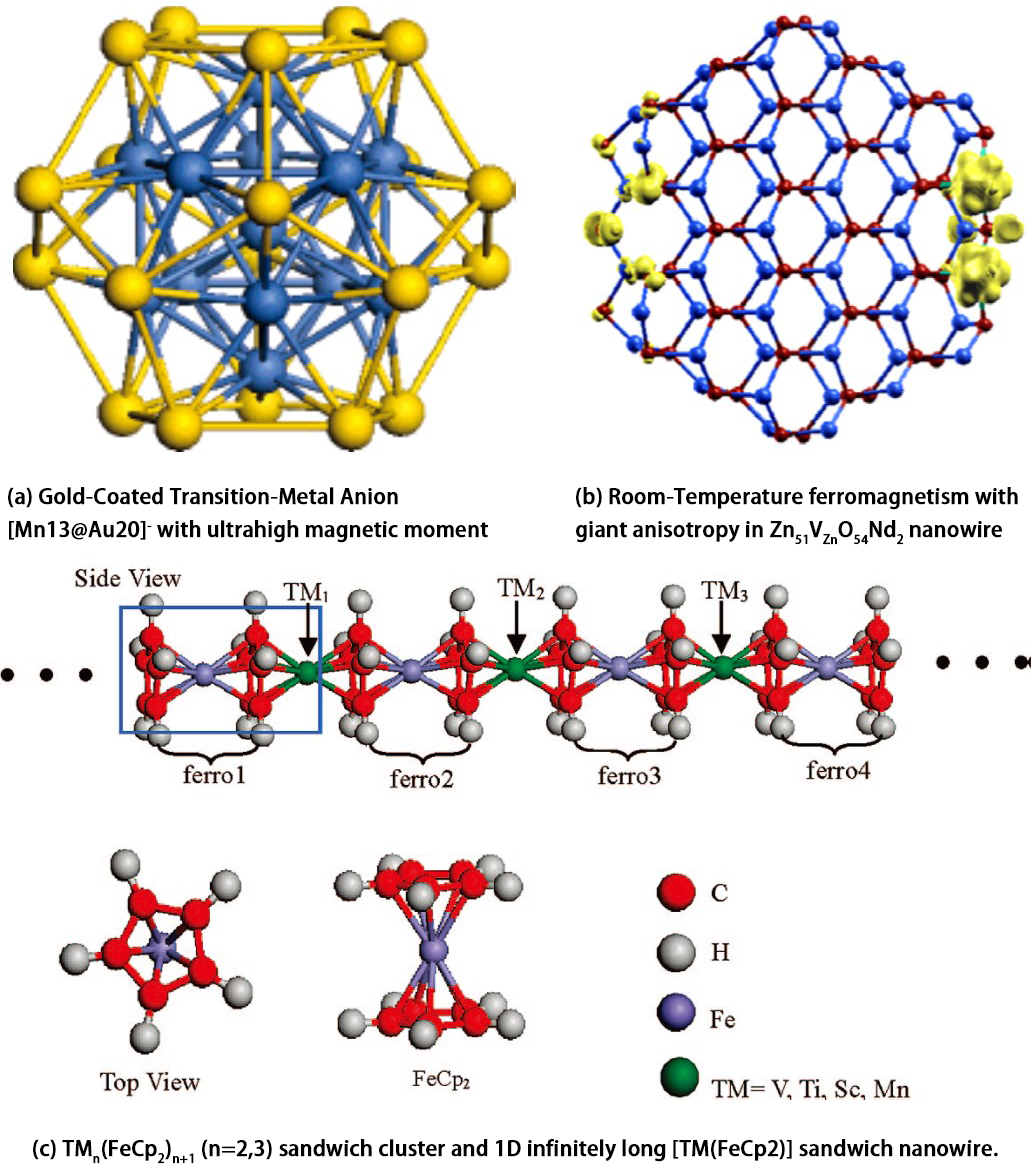Main Research Topics
Computer-aided multiscale simulations play an increasingly important role in the discovery of new functional materials. Our group mainly focuses on electronics, optoelectronics, energy storage and conversion materials, especially two-dimensional materials and perovskites materials, aiming at providing in-depth understanding of their peculiar physical and chemical properties, the influence of defects and environmental factors, and rational design of better functional materials.
I. Novel functional materials discovery via machine learning
Rapidly discovering novel functional materials remains an open challenge because the traditional trial-and-error methods are usually inefficient especially when thousands of candidates are treated. We are focused on the study of accelerating the novel functional materials discovery combining machine learning techniques and density functional theory (DFT) calculation.
We have developed a target-driven method, combining machine learning techniques and density functional theory calculations, to predict undiscovered hybrid organic–inorganic perovskites (HOIPs) for photovoltaics. Successfully, six orthorhombic lead-free HOIPs with proper bandgap for solar cells and room temperature thermal stability are screened out from 5158 unexplored HOIPs and two of them stand out with direct bandgaps in the visible region and excellent environmental stability. Essentially, a close structure-property relationship mapping the HOIPs bandgap is established. [Shuaihua Lu, Qionghua Zhou, Yixin Ouyang, Yilv Guo, Qiang Li, Jinlan Wang. Nat. Commun. 2018, 9, 3405]
II. Two-Dimensional (2D) Materials
1. Graphene: Nanoribbons and CVD Growth
(1) Making graphene nanoribbons We have proposed an efficient process to unzip single-walled carbon nanotubes into narrow graphene nanoribbons in H2 [Jinlan Wang, et al. Angew. Chem. Int. Ed. 2011, 50, 8041 ]. With the help of a single transition-metal atom, the energy barrier of the entire process is significantly reduced to 1.16 eV, indicating that the unzipping process might occur at a slightly elevated temperature (e.g., 200~300 °C), which is important for electronic and spintronic device fabrication. We have also demonstrated that graphene can be cut into graphene nanoribbons on oxidation with the assistance of a uniaxial external tensile strain. [1. Liang Ma, et al. Angew. Chem. Int. Ed. 2012, 51, 1161. 2. Liang Ma, et al. ChemPhysChem 2013, 14, 47]
(2) Tri-wing graphene Nanoribbons. We have designed a new class of quasi one-dimensional graphene nanostructures, namely,tri-wing graphene nanoribbons, which possess significantly augmented mechanical stability against torsional and compression forces, and also each wing of the TWG can retain independent electronic properties of the constituent graphene nanoribbons [Liyan Zhu, et al. Nano Lett. 2010, 10, 494].
(3) CVD growth mechanism of graphene and its exfoliation. By employing classical molecular dynamics with the ReaxFF potential, we have investigated the evolution of carbon structures and the growth kinetics of graphene on Ni(111) surface at different temperatures [Lijuan Meng, et al. J. Phys. Chem. C 2012, 116, 6097]. After that, we have theoretically explored the atomic mechanism of oxygen intercalation through metal passivated graphene edges to decouple CVD grown graphene from metal substrate on thermodynamic and kinetics aspects, and successfully identified the rate-limiting steps. [Liang Ma, et al. J. Phys. Chem. Lett. 2015, 6, 4099]
2. MoS2 Monolayer: Defect Engineering
(1) Hopping transport through defect-induced localized states in MoS2. By cooperating with experimental groups, we provide direct evidence that sulphur vacancies exist in molybdenum disulphide, introducing localized donor states inside the bandgap. Under low carrier densities, the transport exhibits nearest-neighbour hopping at high temperatures and variable-range hopping at low temperatures, which can be well explained under Mott formalism. Our study reveals the important role of short-range surface defects in tailoring the properties and device applications of molybdenum disulphide. [Hao Qiu, et al. Nat. Cummun. 2013, 4, 2642.]
(2) Repair of S vacany by thiol chemistry. We have shown that thiol chemistry is an effective approach to engineer the defects and interface in monolayer MoS2 towards intrinsic charge transport. A physical model that includes charge traps and major scattering sources has been developed to comprehensively describe the charge transport in MoS2 and to quantify the density of CI and charge traps in the samples. [Zhihao Yu, et al. Nat. Commun. 2014, 5, 5290.]
(3) Defected MoS2 for hydrogen evolution reaction (HER). We systematically evaluate the capabilities of 16 kinds of structural defects including point defects (PDs) and grain boundaries (GBs) to activate the basal plane of MoS2 monolayer, Our calculations show that six types of defects can greatly improve the HER performance of the in-plane domains of MoS2, providing a comprehensive picture of the defect-engineered HER activities of a MoS2 monolayer and opening a new window for optimizing the HER activity of twodimensional dichalcogenides for future hydrogen utilization. [Yixin Ouyang, et al. Chem. Mater. 2016, 28, 4390]
(4) Eenhanced optical absorption of a defective MoS2 through oxygen passivation. Our calculations have proved that the sulfur vacancies can be finely repaired by oxygen passivation and are beneficial to the formation of the stable localized excitons, which greatly enhance the optical absorption in the spectral range. The defect-mediated/-engineered absorption mechanism is well understood, which offers insightful guides for improving the performance of twodimensional dichalcogenide-based optoelectronic devices.[Huabing Shu, et al. ACS Appl. Mater. Interfaces, 2016, 8, 13150]
3. Black Phosphorus (BP): Degradation Mechanism and Protection
(1) Degradation mechanism of BP. The air-stability of BP is very poor. Based on ab initio calculations, we have provided a three-step picture on the ambient degradation of BP: generation of superoxide under light, dissociation of the superoxide, and eventual breakdown under the action of water. A possible protection strategy using a fully oxidized BP layer as the native capping is proposed as well. Such a fully oxidization layer can resist corrosion from water and leave the BP underneath intact with simultaneous high hole mobility . [Qionghua Zhou, et al. Angew. Chem. Int. Ed. 2016, 128, 11609]
(2) Chemical functionalization of BP. We have proposed to use polymers bonded to BP surface, aiming at a balance between functionality and carrier mobility. The polymer−BP composites preserve both electron and hole mobility of pristine BP. Meanwhile, the stability of polymer−BP composites in ambient condition is enhanced as well. [Qiang Li, et al. J. Phys. Chem. Lett. 2016, 7, 4540]
(3) Passivation of BP via self-assembled organic monolayers by vdW Epitaxy. We have proposed a new and effective passivation strategy, self-assembly of organic monolayers on BP via vdW epitaxy, to achieve the fine encapsulation of BP. Our multiscale simulations demonstrate organic molecules do not break the original electronic properties of BP and are able to selfassemble into a stable and close-packed herringbone hydrogenbonded network on BP around 400 K via vdW epitaxy. [Yinghe Zhao, et al. Adv. Mater. 2017, 29, 1603990.]
4. Heterostructures: Organic and Inorganic
(1) 2D organic molecular crystal on graphene/BN. Two-dimensional atomic crystals are extensively studied in recent years, while a molecular counterpart is still challenging. We have determined the detailed structure of 2D C8-BTBT crystal based on combined STM and density functional theory studies. The results show that the interfacial layer lie down lie down on graphene/BN, while the first layer leans to a degree and the second layer stands up. [1. Daowei He, et al. Nat. Commun. 2014, 5, 5162; 2. Bing Wu, et al. Nano Lett. 2016, 16, 3754.] Furthermore, we have visualized the nanoscale self-assembly of organic molecules on graphene and BN from a disordered state to a 2D lattice via molecular dynamics simulation for the first time. It is revealed that the assembly toward 2D ordered structures is essentially the minimization of the molecule−molecule interaction that are the decisive factors for the formation of the 2D ordering. The role of the substrate is mainly governing the array orientation of the adsorbates. The mechanisms unveiled here are generally applicable to a broad class of organic thin films via vdW epitaxy. [1. Yinghe Zhao, et al. J. Phys. Chem. Lett. 2015, 6, 4518. 2. Yinghe Zhao, et al. J. Phys. Chem. C 2017, 121, 4488]
(2) Heterostructures composed of 2D atomic crystals. We have proposed that uniformly wetting deposition of Co atoms on MoS2 monolayer can generates a new 2D robust half-metallic ferromagnet [Qian Chen, et al. ACS Appl. Mater. Interfaces 2014, 6, 16835]. We also have studied the electronic structure of nontwisted and twisted bilayers of hybrid graphene/MoS2. Gr/MoS2 shows significant differences in band structures from the nontwisted ones with the appearance of the crossover between direct and indirect band gap and gap variation. More interestingly, band structures of twisted graphene/MoS2 with different rotation angles are very different from each other [Zilu Wang, et al. J. Phys. Chem. C. 2015, 4752]. Besides, we have designed a graphitic zinc-oxide-based (g-ZnO) intrinsic type-II heterostructure, g-ZnO/blue phosphorus (BP), based on first-principles calculations. The type-II band offsets and large built-in electric field ensure the photogenerated electrons easily migrating from g- ZnO to BP, which significantly enhances the separation of electron−hole pairs. Improved optical absorption is also observed in the heterostructure. [Xianghong Niu, et al. J. Phys. Chem. C. 2017, 121, 3648]
III. Construction of new molecular magnetic material and its interacting mechanism
The various properties of and spintronic interactions between atoms in magnetic microstructures play an important role in design and development of spintronic devices. We are focused on the study of construction and interacting mechanism in new molecular magnetic nanostructures, including 0D atomic clusters, 1D metal-organic sandwich nanowires and magnetic doping in ZnO.
Gold-Coated Transition-Metal Anion [Mn13@Au20]- with Ultrahigh Magnetic Moment. We have presented results of DFT computations which show that coating magnetic clusters with gold can both enhance (as in the case of [Mn13@Au20]-) and attenuate (as in the case of [Co13@Au20]-) the net magnetic moment of the clusters. The degree of magnetic enhancement for [Mn13@Au20]- (44 μB) as well as the cluster’s bistability at both low (2 μB) and high (44 μB) spin states suggests that the gold-coated manganese clusters may be good prototype systems for nanomagnetism applications. [Jinlan Wang, et al. J. Am. Chem. Soc. 2007, 129, 4111]
TMn(ferrocene)n+1 Sandwich Clusters and Molecular Wires. We have studied the structural and magnetic properties of TMn(ferrocene)n+1(TM=Sc, Ti, V, Mn) sandwich clusters and nanowires (n=∞), which are highly stable and form polyferrocene-like sandwich structures. The total magnetic moment of TMn(ferrocene)n+1(TM=Sc, Ti, V, Mn) increases linearly with the size n. The tunable magnetic properties of TM-Cp sandwich clusters and nanowires may be exploited for applications in nanoelectronics and spintronics. [Xiuyun Zhang, et al. ACS Nano 2009, 3, 537]
Other representative works: 1) Jinlan Wang, et al. J.Am.Chem.Soc. 2005, 127, 2812. 2) Xiuyun Zhang, et al. ACS Nano 2009, 3, 2515. 3) Liyan Zhu, et al. J. Phys. Chem. A 2010, 114, 9398. 4) Tingting Zhang, et al. J. Phys. Chem. C 2011, 115, 14542. 5) Dandan Wang, et al. Nano Lett. 2012, 12, 3994. 6) Xiaojing Yao, et al. International Journal of Quantum Chemistry 2015, 115, 607. 7) Xiaojing Yao, et al. J. Phys. Chem. C 2016, 120, 7088
Funding list
| No. | Foundation Name | Foundation Source | From | To |
|---|---|---|---|---|
| 1 | Simulation and Design of Graphene-like Materials for Electrolytic Hydrogen Evolution | Natural Science Foundation of China(21773027) | 2018.1 | 2020.12 |
| 2 | Theoretical Chemistry of Low-Dimensional Materials | The National Science Fund for Distinguished Young Scholars(21373045) | 2016.1 | 2020.12 |
| 3 | Research on Electronic Structures and Optical Properties of Atomic-Thin Two-Dimensioal MoS2 Layered Materials | Natural Science Foundation of China(20130092110029) | 2014.1 | 2016.12 |
| 4 | Theoretical Research on Electronic Structures and Optical Properties of Graphene-Like Transition Two-Dimensional Metal Dichalcogenide Materials | Natural Science Foundation of China(21373045) | 2013.1 | 2017.1 |
| 5 | Research on Growth Mechanism and Optoelectronic Properties of Graphene/MoS2 Layered Materials and Their Applications in Utilization of Solar Energy | Key Project of Natural Science Foundation of Jiangsu Province(BK20130016) | 2013.7 | 2016.6 |
| 6 | Theoretical Research on CVD Growth Mechanism of Graphene and Cutting Carbon Nanotube to Make Graphene Nanoribbons | Natural Science Foundation of China | 2012 | 2015 |
| 7 | Fundamental Research on Group Ⅱ Oxide Semiconducting Optoelectronic Devices | The People's Republic of China Ministry of Science and Technology |
2011 | 2015 |
| 8 | Research on Structures, Electronic and Magnetic Properties and Transport Behaviors of Organic-Metal Sandwich Clusters and Nanowires | National Natural Science Foundation of China | 2011 | 2013 |
| 9 | Quantum Effect of Low-Dimensional Spintronic Systems | The People's Republic of China Ministry of Science and Technology | 2010 | 2014 |
| 10 | Research on Complex Electronic and Magnetic Properties and Adsorption Behaviors of Bi-Gold Clusters | The People's Republic of China Ministry of Education | 2010 | 2012 |
| 11 | Fundamental Research on Environment-Friendly Modern Concrete | The People's Republic of China Ministry of Science and Technology | 2009 | 2010 |
| 12 | Magnetic Properties and Adsorption Behaviors of Transition Metal Oxide Clusters | National Natural Science Foundation of China | 2009 | 2011 |
| 13 | New Century Excellent Talents Supporting Plan of Ministry of Education | The People's Republic of China Ministry of Education | 2007 | 2009 |
| 14 | Theoretical Research on Metal Compound Sandwich Clusters | National Natural Science Foundation of China | 2007 | 2009 |
| 15 | Sponsorship Program for Young Faculties of Southeast University in Teaching and Research | University Special Project | 2006 | 2009 |






